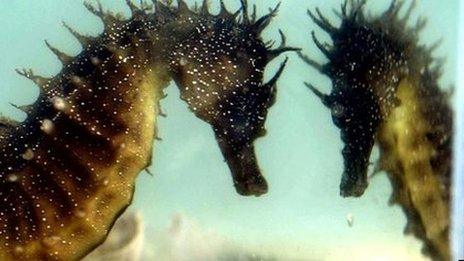English seas get new marine conservation zones
- Published

A total of 27 new marine conservation zones will be created in English seas to protect coral reefs and sea-life
The government has announced it will create 27 new marine conservation zones (MCZs) to protect wildlife in the seas around the English coast.
The MCZs will help seahorses, coral reefs and oyster beds to remain safe from dredging and bottom-trawling.
The Marine Conservation Society welcomed the "significant milestone".
But it warned there were still fewer than a quarter of the number of MCZs recommended by scientists to complete an "ecologically coherent" network.
'Better protected'
Last December a two-year £8m consultation involving the government's own science advisers recommended the creation of 127 MCZs to halt the rapid decline of fish, lobsters, oysters and seahorses.
But earlier this year, ministers announced plans to construct just 31 zones aimed at protecting life on the ocean floor.
At the time, campaigners described the plan as "pitiful" and a "bitter disappointment" - but the then environment minister Richard Benyon insisted that the scientific evidence for a large proportion of the zones was "just not up to scratch".
He said another £3.5m was being spent on gathering more evidence that could support more zones being designated in future.
Announcing the 27 new zones, marine environment minister George Eustice said the department was doing "more than ever" to protect England's marine environment and almost a quarter of English inshore waters and 9% of UK waters would be "better protected".
He said that the new MCZs - which would join over 500 marine protected areas that already exist - would cover an area roughly three times the size of Wiltshire and would span the waters around the English coast.
The scheme would ensure areas such as Chesil Beach and the Skerries Banks are safeguarded.
The minister said that the number of new sites had been reduced from 31 to 27 because two of the sites - at Stour and Orwell and Hilbre Island - were too costly,
A final decision on the two remaining sites - at Hythe Bay and North of Celtic Deep - will be made in the next phase of the project.
The areas within which are the new MCZs, external are:
Inshore sites:
Blackwater, Crouch, Roach and Colne Estuaries, Essex;
Aln Estuary, Northumberland;
Beachy Head West, East Sussex;
Chesil Beach and Stennis Ledges, Dorset;
Cumbria Coast;
Folkestone Pomerania, Kent;
Fylde, Lancashire;
Isles of Scilly;
Kingmere, Sussex;
Lundy;
The Manacles, Cornwall;
Medway Estuary, Kent;
Padstow Bay and Surrounds, Cornwall;
Pagham Harbour, Sussex;
Poole Rocks, Dorset;
Skerries Bank and Surrounds, Devon;
South Dorset;
Tamar Estuary, Devon/Cornwall;
Thanet Coast, Kent;
Torbay, Devon;
Upper Fowey and Pont Pill, Cornwall;
Whitsand and Looe Bay, Cornwall
Offshore sites:
The Canyons, Cornwall;
East of Haig Fras, Cornwall;
North East of Farnes Deep, Northumberland;
South-West Deeps (West), Cornwall;
Swallow Sand, Northumberland
Mr Eustice also announced plans to designate two more phases of MCZs over the next three years, with a consultation on the next phase expected to be launched in early 2015.
"This is just the beginning," he said.
'Threatened sea bed'
Melissa Moore, senior policy officer at the Marine Conservation Society, said that the organisation broadly welcomed the new proposals.
"This announcement is a significant milestone for marine conservation", she said.
But she added: "We urge government to bring forward designation of future tranches to prevent many threatened seabed habitats being further damaged - these 27 sites represent less than a quarter of the number recommended by scientists to complete an 'ecologically coherent' network."
She also pointed to the need to "police" potentially damaging activities.
"The MCZs will be multi-use, so low-impact fishing such as potting will be permitted in most sites," she said.
"It is vital that within these sites there is a clear notion of what can and can't happen, and who is responsible for policing those activities, otherwise we're just creating paper parks."
Defra said it had received around 40,000 responses to their consultation to 31 March 2013, which asked for feedback on the proposals via their website.
- Published14 October 2012
- Published17 June 2012
- Published8 September 2011
- Published31 July 2012